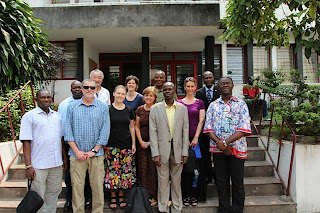 |
| My sister is shown in the brown outfit towards the center of the group. |
What an adventure my sister had on her recent trip to the Congo! I am so thankful she is safely back, along with all her team members. The stories she tells of her experiences there have been truly amazing...stories of sadness and poverty and stories of hope and joy.
I am loving hearing about her journey of a lifetime.
Photographs to go along with the stories and faces are my favorite way of encountering her journey.
Below are some of the special photos she shared with me. She says that most people loved getting their pictures taken.
Below are some of the special photos she shared with me. She says that most people loved getting their pictures taken.
Diann brought me back some pieces of her journey in the way of fabric lengths. She met a seamstress named Euphrasie. As a sewist myself, I am especially honored to "meet" her!
First, meet her daughter:
 | |
| Euphrasie has 6 children Shown here - her daughter wearing the liputa (wrapped skirt) and kitambala (head wrap.) |
I am intrigued by the patterns on the fabrics and want to learn more about the African wax techniques. A bit of research I would now like to share with you, too.
African wax fabric refers to the batik-like process for printing the designs on the fabric.
Origins for the technique seem to come from Indonesia and the Dutch.
China now imports some of the fabrics to back to Ghana. Many designs are renditions of plants and animals.
Now, meet Euphrasie - a woman of joy who loves God.
African wax fabric refers to the batik-like process for printing the designs on the fabric.
Origins for the technique seem to come from Indonesia and the Dutch.
China now imports some of the fabrics to back to Ghana. Many designs are renditions of plants and animals.
Now, meet Euphrasie - a woman of joy who loves God.
 | |
| Euphrasie sold a few fabric lengths from the home of short-term missionary Christine Buettgen. |
 |
| With a tape measure around her neck, Euphrasie operates the hand-powered sewing machine while her sewing students look on. I remember my Grandma using a machine like this. |
Fabric designs can tell stories of relevance to the wearer.
Examples of significant events are depicted below:
 |
| Take a close-up look: Covenanters will recognize our denomination logo in this picture! |
Proverbs, poems and fables are represented by the designs in the fabric.
An example of this was found at
http://www.thewrendesign.com/the-story-behind-african-wax-print-cloth/
(WREN blog)
when the author wrote about "Ahonnee pa nkasa" which translates to
"Precious beads make no noise."
The meaning: a good person needs not blow her/his own horn.
Another proverb example:
"Sika wo antaban" meaning "Money has
wings". This warns people against lavish spending and also suggests that
careful use of money can bring success.
 |
| This is a photo of a fabric market in Gemena. |
Colors in the African wax fabrics can represent social standing in the community.
(In the picture, below, my sister and I are standing by a pool.She and her trip team members had just presented their experiences, comments and slides to a very interested congregation at Naperville Covenant Church.)
(In the picture, below, my sister and I are standing by a pool.She and her trip team members had just presented their experiences, comments and slides to a very interested congregation at Naperville Covenant Church.)
 | |||
| Euphrasie made this liputa especially for Diann. |
Thanks, Sis, for these special fabrics you brought back for me!
It's going to be so much fun to figure out how to use them.
For more information about African wax prints, just go online to the search engine of your choice.
There's a lot of interesting info out there!


Thanks for sharing.
ReplyDeleteVisit Operion for Ecommerce Website|Online Billing Payment| E-Billing | Web Based Billing System
Wow! This is a great post. What a trip of a lifetime, indeed. How interesting that the fabrics are status symbols (interesting for the sociologist). Thank you for sharing Diann's stories. What a storyteller you are, with both pictures and words expertly used to tell the story. I miss you both!
ReplyDelete